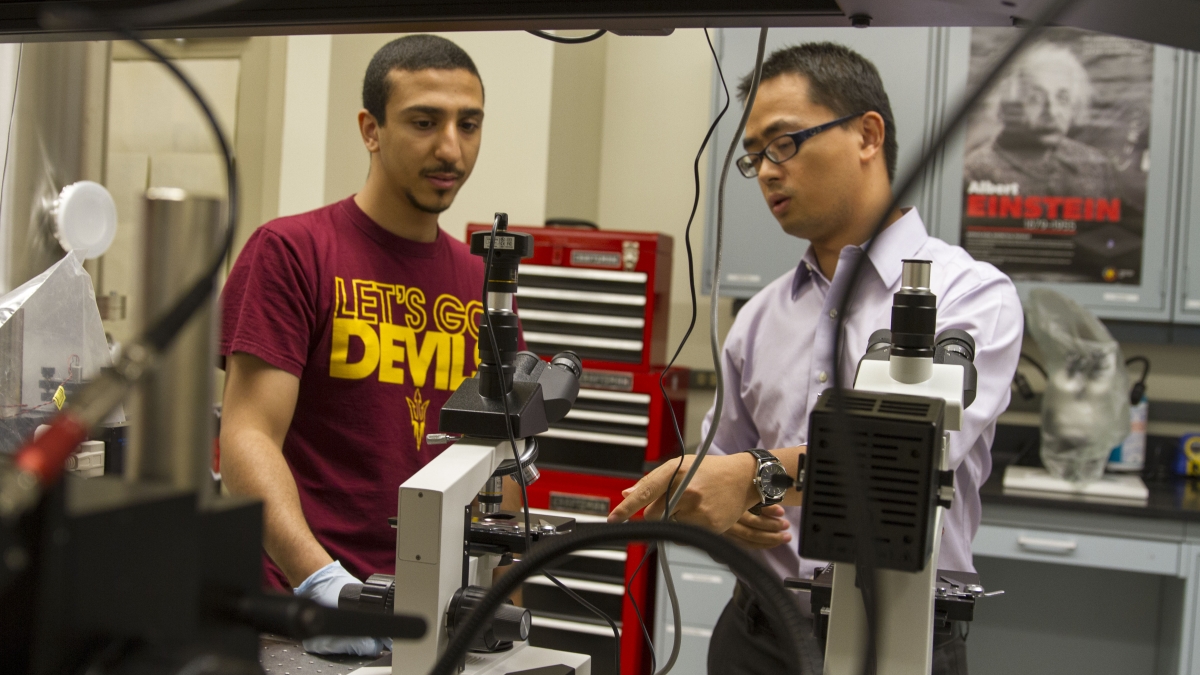Manufactured materials offer benefits to energy sector, climate change

Assistant professor Liping Wang (right) and Hassan Alshehri, a mechanical engineering doctoral student, research manufactured materials as part of Wang's Nano-Engineered Thermal Radiation Group. Photo by Nora Skrodenis/ASU
Mechanical engineer Liping Wang imagines an energy sector enhanced by greater control over thermal radiation. To work toward this objective, he is designing and constructing a host of custom electromagnetic materials.
An assistant professor at Arizona State University, Wang's endeavor is supported by a Young Investigator Program research grant from the Air Force Office of Scientific Research, totaling $360,000 over three years. The program received more than 230 proposals, awarding grants to only 25 percent of applicants.
Thermal radiation refers to the transfer of energy through electromagnetic waves between objects.
Improving thermal radiation and its transport boasts improvements in energy harvesting, as well as thermal management, imaging and sensing — all of which are essential in addressing the world’s urgent need for high-efficiency renewable energy sources and energy-saving materials.
But the quality of thermal radiation, and the energy it generates, is determined by the temperature and properties of the objects, known as emitters and receivers, at play.
Currently, in thermophotovoltaic systems (systems that convert thermal energy to power), efficiency is very low due to the performance of materials that make up the emitters and receivers. These systems commonly suffer from a loss of heat — known as waste heat — rather than using that heat to generate additional electricity.
All of this results in less efficient photovoltaics and is an obstacle in ramping up the usage of solar energy and waste heat, which can be recovered and used as an emission-free and affordable energy resource.
A solution to the problem lies in designing emitters and receivers made of materials that are near-perfectly efficient in their absorption of sunlight — meaning materials that can selectively control thermal radiation and enhance radiative transport. By extension, this research could help create solar cells that produce more energy, more efficiently.
The game-changing nanoengineered materials that Wang is developing are nanowire-based metamaterials.
These manufactured metamaterials are electromagnetic structures that are deliberately engineered to offer a range of unique electromagnetic properties, which are much more difficult, if not impossible, to achieve in naturally occurring materials or composites, such as rare-earth oxides as wavelength-selective emitters.
“These metamaterials would provide much more flexibility and tunability in materials designed to achieve the best system performance,” said Wang, a faculty member in ASU's Ira A. Fulton Schools of Engineering.
Wang said a significant feature of his metamaterials is their ability to respond to both electrical and magnetic fields at optical frequencies. All lights or electromagnetic waves are made of co-existing electric and magnetic fields, which Wang likens to the “left and right hands of a person.”
“Most natural materials only interact with electrical fields of lights at optical frequencies; in other words, they behave non-magnetically,” said Wang.
During the thermal radiation process, Wang’s nanowire metamaterials can interact with both the electric and magnetic fields, which allows for improved control of light propagation, absorption and emission with “both hands” of the wave.
This control is termed “spectral selectivity,” and can lead to greater energy efficiency and power input by improving the conversion of thermal energy into electricity.
“In addition, the project fundamentally investigates the unexploited radiative thermal transfer process between these unique metamaterials separated by nanometer-scale vacuum gaps,” said Wang, which could further enhance the performance of thermophotovoltaic energy conversion or thermal management.
“We aim to engineer these novel materials for developing high-efficiency renewable energy sources, recuperating waste heat, facilitating thermal managements and mitigating climate change,” said Wang.
About 60 percent of the total energy that is produced in United States is wasted in the form of heat during production, transportation and storage.
“Recycling of such a huge amount of waste heat with highly efficient energy-conversion devices will undoubtedly reduce the amount of fuel consumption and greenhouse gas emission by up to 30 percent,” said Wang. This could alleviate the pressing demand for conventional energy sources and reduce carbon dioxide pollution.
In addition, by funding this research, the Air Force is likely interested in applications to improve optical cloaking and infrared detection.
In his efforts in the Nano-Engineered Thermal Radiation Group, Wang engages a postdoctoral fellow, seven doctoral students including two visiting students from China, and three undergraduates as part of the Fulton Undergraduate Research Initiative.
More Science and technology

ASU researcher part of team discovering ways to fight drug-resistant bacteria
A new study published in the Science Advances journal featuring Arizona State University researchers has found…

ASU student researchers get early, hands-on experience in engineering research
Using computer science to aid endangered species reintroduction, enhance software engineering education and improve semiconductor…

ASU professor honored with prestigious award for being a cybersecurity trailblazer
At first, he thought it was a drill.On Sept. 11, 2001, Gail-Joon Ahn sat in a conference room in Fort Meade, Maryland.…